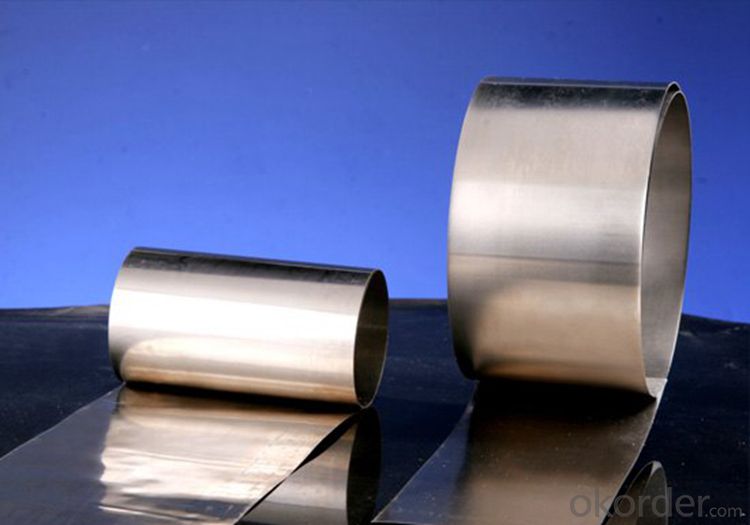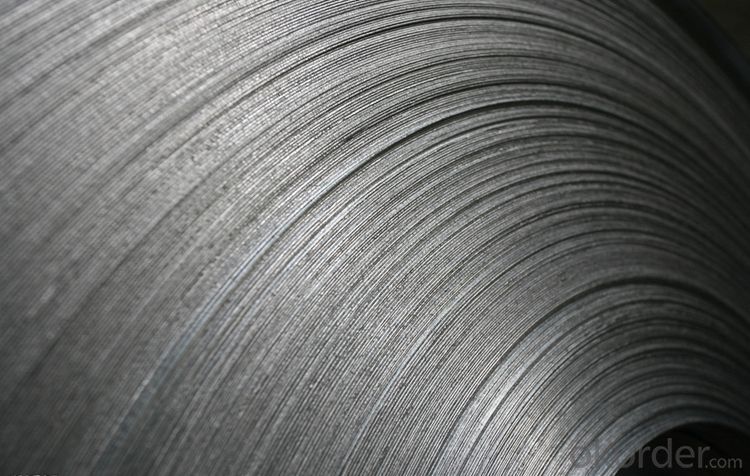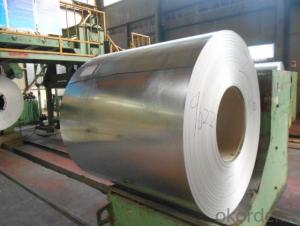Stainless Steel Coils,Steel Sheets,Steel Plates from China
- Loading Port:
- China main port
- Payment Terms:
- TT OR LC
- Min Order Qty:
- 18 m.t.
- Supply Capability:
- 1000000 m.t./month
OKorder Service Pledge
OKorder Financial Service
You Might Also Like
Item specifice
Products Description
Product | stainless steel coils/plates/sheets | ||
Discharge Port | Any Port, China | ||
Size | Coils | Cold Rolled: | Thickness0.3-8mm,Width:280-2100mm |
Hot Rolled : | Thickness3-14mm,Width:650-2100mm | ||
Plates | Thickness2-80mm,Width:1500-3000mm | ||
Coil Weight | About 20 Tons | ||
Grade | 201,202,304/304L/304H,316/316L/316H,321/H,310S,409/L,430 etc. | ||
Technique | Hot Rolled/Cold Rolled | ||
Finish | 2B, BA, 2D, No1, No2, No4,NO.8,SB etc | ||
Edge | Mill Edge / Slitting Edge | ||
Package | In bundles, or as customer's requirement | ||
Place of Origin | Made in China | ||
MOQ | 20 Tons | ||
Payment Terms | 100% LC at sight,or 30%TT in advance, balance against B/L copy | ||
Delivery Time | With 30-40 days after deposit | ||
Packaging & Delivery
Packaging Detail | Standard export packing or following customer's demand |
Delivery Time | Within 30-40 days after deposit or according to the order quantity |
Detail picture of Products:



Application:
Finish | Definition | Application |
2B | Those finished, after cold rolling, by heat treatment, pickling or other equivalent treatment and lastly by cold rolling to given appropriate luster. | Medical equipment, Food industry, Construction material, Kitchen utensils. |
BA | Those processed with bright heat treatment after cold rolling. | Kitchen utensils, Electric equipment, Building construction. |
NO.3 | Those finished by polishing with No.100 to No.120 abrasives specified in JIS R6001. | Kitchen utensils, Building construction. |
NO.4 | Those finished by polishing with No.150 to No.180 abrasives specified in JIS R6001. | Kitchen utensils, Building construction, Medical equipment. |
NO.1 | The surface finished by heat treatment and pickling or processes corresponding there to after hot rolling. | Chemical tank, pipe. |
FAQ
Q: How long is the delivery time?
A: Normally 30-40 days, but mostly according to the specific requirements or the quantity
Q: Could you send me sample?
A: We can supply you with the sample for free, but the delivery charges will be covered by customers.
- Q:What are the different types of stainless steel sheet surface patterns?
- There are several different types of stainless steel sheet surface patterns that are commonly used in various industries. Some of the most common patterns include: 1. No. 1 Finish: This is the most common type of stainless steel sheet surface pattern. It has a dull, rough, and non-reflective finish, which is achieved by hot rolling the stainless steel sheet. 2. No. 2B Finish: This type of finish has a smooth, moderately reflective surface. It is achieved by cold rolling the stainless steel sheet and then annealing it in a controlled atmosphere to remove any scale or oxide buildup. 3. No. 3 Finish: This finish is similar to the No. 2B finish, but with a slightly coarser and less reflective surface. It is commonly used for decorative purposes, such as in architectural applications. 4. No. 4 Finish: This is a popular choice for stainless steel sheet surfaces. It has a brushed appearance, with fine parallel lines running in one direction. The brushed finish is achieved by using abrasive belts or brushes to create a consistent pattern on the surface. 5. No. 8 Mirror Finish: As the name suggests, this finish provides a highly reflective, mirror-like surface. It is achieved by polishing the stainless steel sheet to a high shine using a series of progressively finer abrasive materials. 6. Embossed Finish: This finish features a raised, textured pattern on the surface of the stainless steel sheet. It can be achieved through various methods, such as embossing rollers or heat transfer. 7. Bead Blasted Finish: This finish has a uniform, matte appearance with a slightly rough texture. It is created by bombarding the stainless steel sheet with fine glass beads at high pressure, resulting in a consistent, non-reflective surface. Each of these stainless steel sheet surface patterns offers unique aesthetic and functional qualities. The choice of pattern depends on the specific application and desired outcome, whether it be for architectural, industrial, or decorative purposes.
- Q:How do you prevent intergranular corrosion in stainless steel sheets?
- Intergranular corrosion in stainless steel sheets can be prevented through various methods such as proper selection of stainless steel grade, heat treatment, and appropriate welding techniques. 1. Stainless Steel Grade Selection: Choosing the right stainless steel grade is crucial in preventing intergranular corrosion. Grades with a low carbon content, such as 304L or 316L, are less susceptible to intergranular corrosion compared to higher carbon grades. These low carbon grades minimize the formation of chromium carbide precipitates, which are the main cause of intergranular corrosion. 2. Heat Treatment: Heat treatment processes like solution annealing and quenching can help eliminate or reduce the formation of chromium carbide precipitates. This treatment restores the stainless steel's corrosion resistance by dissolving existing precipitates and promoting the formation of a protective chromium oxide layer on the surface. 3. Welding Techniques: Careful attention must be given to welding stainless steel sheets to prevent intergranular corrosion. Processes like gas tungsten arc welding (GTAW) or laser welding that provide precise control over heat input are preferred. Additionally, using low carbon filler metals or consumables specifically designed for intergranular corrosion resistance can minimize the risk of corrosion. 4. Post-Weld Cleaning and Passivation: After welding, it is essential to thoroughly clean the welded area to remove any contaminants or oxide scales that could promote corrosion. Acid cleaning followed by passivation helps restore the protective oxide layer and enhances the stainless steel's resistance to intergranular corrosion. 5. Avoiding Sensitization: Sensitization occurs when stainless steel is exposed to high temperatures for extended periods, leading to the formation of chromium carbide precipitates. It is crucial to avoid prolonged exposure to temperatures between 450-850°C (842-1562°F) during fabrication or service to prevent sensitization and subsequent intergranular corrosion. By implementing these preventive measures, intergranular corrosion in stainless steel sheets can be effectively minimized, ensuring the longevity and performance of the material in various applications.
- Q:Can stainless steel sheets be used for exterior cladding?
- Indeed, exterior cladding can utilize stainless steel sheets. The robustness and resistance to corrosion of stainless steel make it appropriate for various purposes, including cladding. Stainless steel sheets present exceptional endurance against weathering, UV rays, and extreme temperatures, rendering them perfect for external usage. They can endure severe environmental conditions, such as heavy rain, snow, and strong winds, without deteriorating or losing their aesthetic charm. Moreover, stainless steel sheets are available in an extensive array of finishes, allowing for customization and design adaptability. Whether for residential, commercial, or industrial edifices, stainless steel cladding offers a durable and visually pleasing solution.
- Q:What are the different types of stainless steel sheet finishes for sanitary applications?
- There are several different types of stainless steel sheet finishes that are commonly used for sanitary applications. These finishes are designed to provide a smooth and clean surface that is resistant to corrosion and bacteria growth. 1. #4 Brushed Finish: This is one of the most common finishes for stainless steel sheets used in sanitary applications. It has a brushed appearance that creates a uniform and consistent texture. It is easy to clean and maintain, making it ideal for environments where hygiene is crucial. 2. #8 Mirror Finish: This finish has a highly reflective surface that resembles a mirror. It is smooth and shiny, making it visually appealing and easy to clean. However, it is important to note that this finish may show scratches and fingerprints more easily than other finishes. 3. 2B Finish: This finish is often used for stainless steel sheets that will be further processed, such as in fabrication or welding. It has a dull and smooth appearance, providing a good base for additional treatments or coatings. 4. Satin Finish: Also known as a No. 4 finish, the satin finish has a low luster and a smooth texture. It is commonly used in sanitary applications where a clean and aesthetically pleasing surface is desired. 5. Bead Blast Finish: This finish is achieved by blasting the stainless steel sheet with fine glass beads. It creates a uniform, non-reflective surface that is easy to clean and resistant to corrosion. The bead blast finish is often used in food processing plants and pharmaceutical facilities. 6. Electropolished Finish: This finish involves an electrochemical process that removes a thin layer of the stainless steel surface, leaving behind a smooth and shiny appearance. It provides a high level of cleanliness and resistance to corrosion, making it suitable for sanitary applications in the pharmaceutical and biotech industries. It is important to consider the specific requirements of the sanitary application when choosing the appropriate stainless steel sheet finish. Factors such as corrosion resistance, ease of cleaning, and aesthetic appearance should be taken into consideration to ensure the best possible outcome.
- Q:Are stainless steel sheets environmentally friendly?
- Yes, stainless steel sheets are considered environmentally friendly. Stainless steel is a highly sustainable material that can be recycled indefinitely without losing its properties. It is non-toxic, durable, and resistant to corrosion, reducing the need for replacements and minimizing waste. Additionally, the production process of stainless steel sheets has a lower environmental impact compared to other materials, making it an eco-friendly choice.
- Q:Are stainless steel sheets suitable for laboratory equipment?
- Yes, stainless steel sheets are highly suitable for laboratory equipment. Stainless steel is known for its excellent corrosion resistance, making it ideal for use in laboratory settings where chemicals and other corrosive substances are frequently used. It is also easy to clean and maintain, which is crucial for maintaining a sterile environment in a laboratory. Furthermore, stainless steel is durable and can withstand high temperatures, making it suitable for a wide range of laboratory applications. Its strength and resistance to impact and wear ensure that laboratory equipment made from stainless steel can withstand rigorous use and last for a long time. Overall, stainless steel sheets offer a reliable and versatile material option for laboratory equipment.
- Q:How do you prevent fingerprints and smudges on stainless steel sheets?
- To prevent fingerprints and smudges on stainless steel sheets, there are a few effective methods you can follow: 1. Clean with microfiber cloth: Use a soft microfiber cloth to wipe the stainless steel surface. Microfiber is gentle and won't leave any scratches or streaks. Avoid using rough materials like paper towels or abrasive sponges. 2. Use a stainless steel cleaner: Invest in a high-quality stainless steel cleaner specifically designed for removing fingerprints and smudges. Follow the instructions on the cleaner and apply it evenly on the surface using a cloth or a sponge. Wipe off any excess cleaner with a clean cloth. 3. Apply baby oil or mineral oil: Apply a small amount of baby oil or mineral oil on a cloth and rub it gently over the stainless steel surface. This will create a thin protective layer that helps prevent fingerprints and smudges from sticking to the metal. 4. Avoid touching the surface with bare hands: One of the main causes of fingerprints and smudges is direct contact with hands. Try to handle stainless steel sheets with clean, dry hands or wear gloves if necessary. This will help minimize the transfer of oils and residue onto the surface. 5. Regular cleaning routine: Establish a regular cleaning routine for your stainless steel sheets. Wipe them down with a microfiber cloth or stainless steel cleaner at least once a week, or more frequently in high-traffic areas. This will prevent the buildup of oils and grime, reducing the chances of fingerprints and smudges. By following these methods, you can effectively prevent fingerprints and smudges on stainless steel sheets, keeping them looking clean and shiny for an extended period of time.
- Q:Are stainless steel sheets resistant to hydrogen embrittlement?
- Stainless steel sheets are commonly resistant to hydrogen embrittlement. Hydrogen embrittlement refers to the brittleness and susceptibility to cracking caused by the diffusion of hydrogen atoms into the metal structure. Nonetheless, stainless steel has a strong resistance to hydrogen embrittlement due to its distinct composition and microstructure. The presence of chromium in stainless steel produces a protective oxide layer on the surface, acting as a barrier against hydrogen diffusion. Furthermore, stainless steel sheets are often alloyed with elements like nickel and molybdenum, further enhancing their resistance to hydrogen embrittlement. However, it is important to note that certain conditions, such as high temperatures or high levels of hydrogen exposure, can still potentially result in hydrogen embrittlement in stainless steel. Hence, it is crucial to consider the specific application and operating conditions when determining the suitability of stainless steel sheets in relation to hydrogen embrittlement.
- Q:What's the difference between stainless steel 304 2B board and Ba board?
- BA 2B process is not the same, finished products are not the same.The BA plate is rolled with a work roll of roughness 0.006-0.008 and annealed in a vertical furnace. The surface is very mirror like;2B edge Miao made by using roughness of work rolls 0.2-0.28, commonly used in horizontal continuous annealing production, rough surface.
- Q:Can stainless steel sheets be used for marine propellers?
- Yes, stainless steel sheets can be used for marine propellers. Stainless steel is a popular choice for marine propellers due to its excellent corrosion resistance properties. The high levels of chromium in stainless steel make it resistant to rust and other forms of corrosion, even in saltwater environments. Additionally, stainless steel offers good strength and durability, making it suitable for withstanding the harsh conditions of marine environments. Stainless steel propellers are often preferred for boats and ships as they require less maintenance and have a longer lifespan compared to other materials. However, it is important to choose the appropriate grade of stainless steel for marine propellers to ensure optimal performance and longevity.
1. Manufacturer Overview |
|
|---|---|
| Location | |
| Year Established | |
| Annual Output Value | |
| Main Markets | |
| Company Certifications | |
2. Manufacturer Certificates |
|
|---|---|
| a) Certification Name | |
| Range | |
| Reference | |
| Validity Period | |
3. Manufacturer Capability |
|
|---|---|
| a)Trade Capacity | |
| Nearest Port | |
| Export Percentage | |
| No.of Employees in Trade Department | |
| Language Spoken: | |
| b)Factory Information | |
| Factory Size: | |
| No. of Production Lines | |
| Contract Manufacturing | |
| Product Price Range | |
Send your message to us
Stainless Steel Coils,Steel Sheets,Steel Plates from China
- Loading Port:
- China main port
- Payment Terms:
- TT OR LC
- Min Order Qty:
- 18 m.t.
- Supply Capability:
- 1000000 m.t./month
OKorder Service Pledge
OKorder Financial Service
Similar products
New products
Hot products
Hot Searches
Related keywords

































